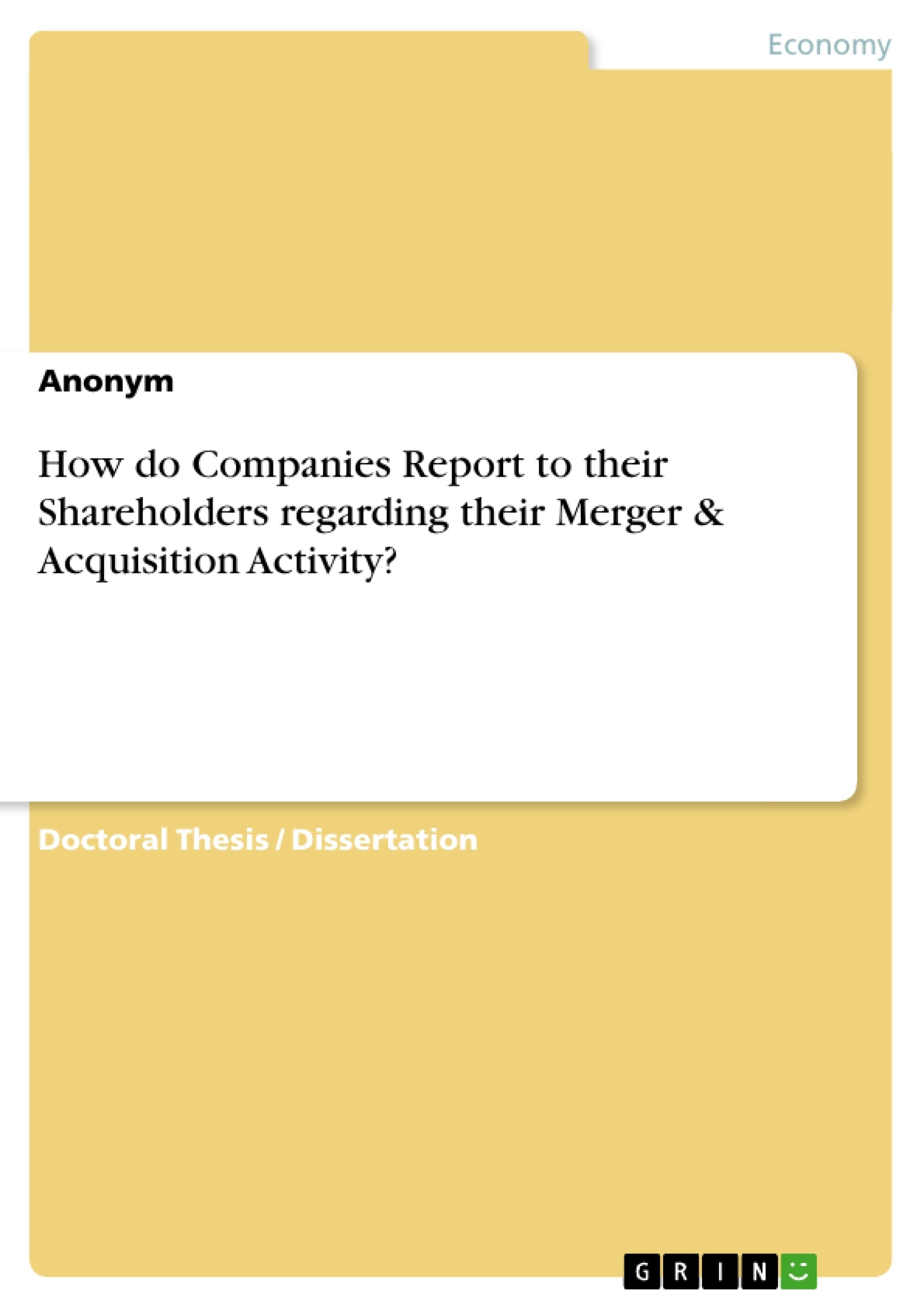With the increase in companies issuing shares as a means of raising capital the way companies are monitored has changed. Incidents such as the Enron scandal serve as a reminder of directors‟ inclination to act in an opportunistic way, with the aim to increase their personal wealth at the expense of their Companies‟ shareholders. As a result of this Corporate Governance regulations have become more stringent in a bid to remove the agency problem, increase the transparency of organisations and protect shareholders. This dissertation looks at how six UK Plc‟s report to their shareholders regarding their merger and acquisition activity, to determine if they comply with the Best Practice guidelines for reporting to shareholders, laid out by academics. The
4
level of communication they provide is considered to ascertain if there is any evidence that the agency problem is still evident within organisations. Using a content analysis of the company information collected the Companies are classified into one of four classifications, depending on the level of communication that they have provided to their shareholders. The role that communication with shareholders plays, in managing shareholder expectations, is also considered when determining if the promises made to shareholders have been fulfilled. This is because acquisitions can be considered a failure by shareholders, even if all promised outcomes have been achieved, because their expectations are higher than those of the Company. Failure to manage expectations indicates that the Company is not transparent enough to the shareholders.
Inhaltsverzeichnis (Table of Contents)
- Abstract
- Acknowledgements
- Chapter 1: Introduction
- 1.1: Introduction to Merger & Acquisition Activity
- 1.2: Corporate Governance and the Agency Problem
- 1.3: The Role of Communication in M&A Activity
- 1.4: Research Questions and Methodology
- Chapter 2: Literature Review
- 2.1: The Agency Problem
- 2.2: Agency Theory and Shareholder Reporting
- 2.3: Communication and Shareholder Relations
- Chapter 3: Methodology
- 3.1: Content Analysis
- 3.2: Data Collection
- 3.3: Data Analysis
- Chapter 4: Findings
- 4.1: Company Reports
- 4.2: Classification of Communication
- Chapter 5: Discussion and Conclusion
- 5.1: Analysis of Communication and the Agency Problem
- 5.2: Implications for Shareholders
- 5.3: Conclusion
Zielsetzung und Themenschwerpunkte (Objectives and Key Themes)
This dissertation examines how six UK Plc's communicate with their shareholders regarding merger and acquisition (M&A) activity. The study aims to determine whether these companies comply with best practices for shareholder reporting and to assess the extent to which the agency problem persists within these organizations. The main objectives are to:- Analyze the content of company reports to shareholders related to M&A activity.
- Classify companies based on their communication levels and adherence to best practice reporting guidelines.
- Investigate the role of communication in managing shareholder expectations during M&A transactions.
- Explore the potential for the agency problem to be evident in the communication practices of these companies.
Zusammenfassung der Kapitel (Chapter Summaries)
- Chapter 1: Introduction This chapter introduces the concept of M&A activity and its significance in the context of corporate governance. It discusses the agency problem, the role of communication in M&A transactions, and outlines the research questions and methodology of the study.
- Chapter 2: Literature Review This chapter explores existing literature related to the agency problem, agency theory, and the impact of communication on shareholder relations. It examines theoretical frameworks relevant to the research.
- Chapter 3: Methodology This chapter details the methodology used in the study. It describes the content analysis technique, data collection process, and the specific approach to data analysis.
- Chapter 4: Findings This chapter presents the results of the content analysis. It analyzes the company reports and classifies the companies based on their communication levels.
Schlüsselwörter (Keywords)
This research focuses on shareholder reporting, agency theory, and content analysis. The study examines the communication practices of companies regarding their merger and acquisition activity. Key concepts explored include corporate governance, transparency, shareholder expectations, and the potential for the agency problem within organizations. The study also examines six specific UK companies: Travis Perkins Plc., Serco Group Plc., Smiths Group Plc., WPP Group, Wolverhampton & Dudley Breweries Plc, and Hanson Plc.- Citation du texte
- Anonym (Auteur), 2008, How do Companies Report to their Shareholders regarding their Merger & Acquisition Activity?, Munich, GRIN Verlag, https://www.grin.com/document/130834



